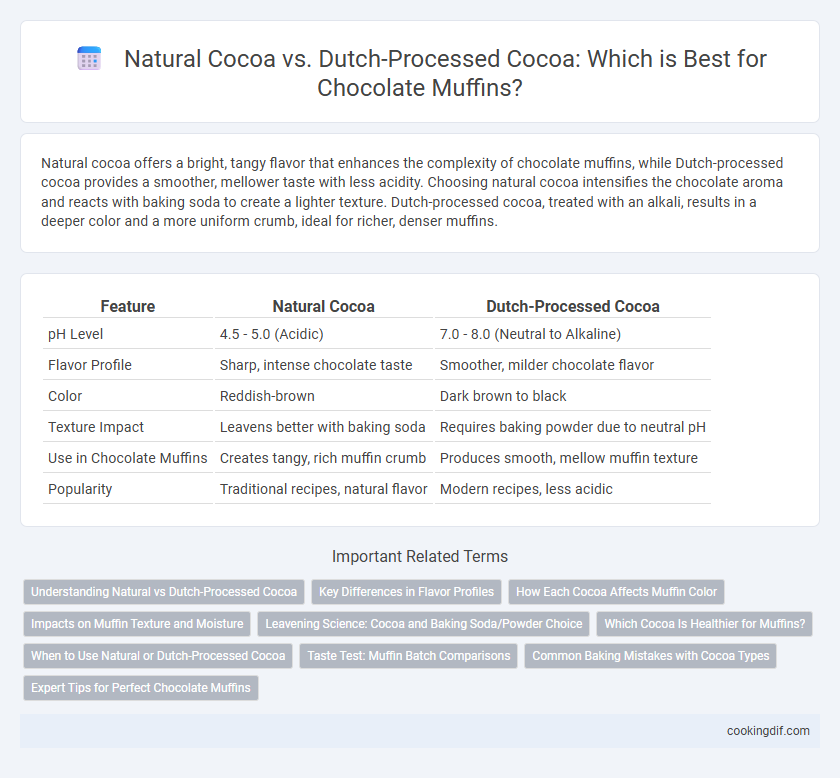Natural cocoa offers a bright, tangy flavor that enhances the complexity of chocolate muffins, while Dutch-processed cocoa provides a smoother, mellower taste with less acidity. Choosing natural cocoa intensifies the chocolate aroma and reacts with baking soda to create a lighter texture. Dutch-processed cocoa, treated with an alkali, results in a deeper color and a more uniform crumb, ideal for richer, denser muffins.
Table of Comparison
| Feature | Natural Cocoa | Dutch-Processed Cocoa |
|---|---|---|
| pH Level | 4.5 - 5.0 (Acidic) | 7.0 - 8.0 (Neutral to Alkaline) |
| Flavor Profile | Sharp, intense chocolate taste | Smoother, milder chocolate flavor |
| Color | Reddish-brown | Dark brown to black |
| Texture Impact | Leavens better with baking soda | Requires baking powder due to neutral pH |
| Use in Chocolate Muffins | Creates tangy, rich muffin crumb | Produces smooth, mellow muffin texture |
| Popularity | Traditional recipes, natural flavor | Modern recipes, less acidic |
Understanding Natural vs Dutch-Processed Cocoa
Natural cocoa is acidic with a bright, fruity flavor that reacts with baking soda to create lift in chocolate muffins. Dutch-processed cocoa undergoes alkalization to reduce acidity, resulting in a smoother, mellow taste and darker color but requires baking powder or additional acid for leavening. Choosing between natural and Dutch-processed cocoa affects the texture, rise, and flavor profile of chocolate muffins, making it essential to match cocoa type with the recipe's leavening agents.
Key Differences in Flavor Profiles
Natural cocoa offers a bright, tangy flavor with a sharp acidity that enhances the depth of chocolate muffins, while Dutch-processed cocoa delivers a smoother, mellow taste with low acidity and a rich, dark color. The natural cocoa's sharper profile can react with baking soda to create a lighter crumb, whereas Dutch-processed cocoa's neutral pH pairs well with baking powder for a tender texture. Choosing between the two affects not only the muffin's flavor complexity but also its rise and overall mouthfeel.
How Each Cocoa Affects Muffin Color
Natural cocoa imparts a lighter, reddish-brown hue to chocolate muffins due to its higher acidity and less alkalized processing. Dutch-processed cocoa, treated with an alkalizing agent, produces a darker, richer color, giving muffins a deep chocolate appearance. The choice between these cocoas directly influences the visual appeal and perceived flavor intensity of the final muffin.
Impacts on Muffin Texture and Moisture
Natural cocoa contains higher acidity and lighter color, which reacts with baking soda to produce a tender crumb and slightly drier texture in chocolate muffins. Dutch-processed cocoa is neutralized with an alkali, resulting in a smoother, richer flavor and darker color that contributes to a moister, denser muffin texture. Choosing between natural and Dutch-processed cocoa directly influences the muffin's crumb structure, moisture retention, and overall softness.
Leavening Science: Cocoa and Baking Soda/Powder Choice
Natural cocoa, with its acidic pH around 5-6, reacts effectively with baking soda (sodium bicarbonate) to create carbon dioxide bubbles, enhancing muffin rise and crumb texture. Dutch-processed cocoa is alkaline and neutral in pH, requiring baking powder, which contains both acid and base, to achieve proper leavening in chocolate muffins. Selecting the correct match between cocoa type and leavening agent ensures optimal muffin volume and tender crumb by controlling the chemical reactions during baking.
Which Cocoa Is Healthier for Muffins?
Natural cocoa contains higher acidity and retains more antioxidants like flavonoids, promoting heart health and providing a richer nutrient profile for chocolate muffins. Dutch-processed cocoa, treated with an alkalizing agent, has a milder flavor and darker color but reduced antioxidant levels, which may lessen some health benefits. When prioritizing health in chocolate muffins, natural cocoa is generally the better choice due to its preserved natural compounds and higher antioxidant content.
When to Use Natural or Dutch-Processed Cocoa
Natural cocoa, known for its acidic pH and bright, fruity flavor, is ideal for recipes using baking soda as a leavening agent because it reacts to create lift and tenderness in chocolate muffins. Dutch-processed cocoa, alkalized for a smoother, milder taste and neutral pH, works best when combined with baking powder, ensuring consistent rise without the acidic tang, producing softer and darker muffins. Choose natural cocoa for bold, tangy notes and Dutch-processed cocoa for mellow, rich chocolate in your muffin recipes.
Taste Test: Muffin Batch Comparisons
Natural cocoa imparts a sharp, fruity acidity that enhances the bright chocolate notes in muffins, creating a lively flavor profile. Dutch-processed cocoa offers a smoother, milder taste with deeper chocolate richness due to its alkalization, resulting in a more balanced and less bitter muffin. Muffin taste tests reveal natural cocoa delivers a tangier, more vibrant chocolate experience, while Dutch-processed produces a velvety texture and mellow chocolate flavor preferred for richer dessert muffins.
Common Baking Mistakes with Cocoa Types
Using natural cocoa powder instead of Dutch-processed cocoa in chocolate muffins often causes incorrect pH balance, leading to improper leavening and a denser texture. Many bakers mistakenly substitute one for the other without adjusting acidic ingredients like baking soda, resulting in flat or bitter muffins. Understanding the chemical differences between natural and Dutch cocoa is crucial to prevent common baking errors and achieve the perfect rise and flavor.
Expert Tips for Perfect Chocolate Muffins
Natural cocoa powder, with its acidic pH of 5 to 6, reacts with baking soda to produce a lift in chocolate muffins, resulting in a lighter texture and tangier flavor. Dutch-processed cocoa is alkalized, with a neutral pH, so it requires baking powder for leavening and offers a smoother, deeper chocolate taste. Expert tips suggest choosing natural cocoa powder for recipes relying on baking soda to achieve optimal rise and using Dutch-processed cocoa when a mellow chocolate intensity and a darker muffin color are preferred.
Natural cocoa vs Dutch-processed cocoa for chocolate muffins Infographic

 cookingdif.com
cookingdif.com